Let’s talk about your about page.
Arguably the most important page on your website, aside from perhaps your sales/ work-with-me/ shop page where you share all of your wonderful creative offerings.
I’ll start with a question. When you visit someone’s website for the first time, what’s the first thing you do? Once you’ve done a quick scroll through the home page, what’s the first page you click on afterwards?
For me, it’s almost always the about page. I want to get to know the artist behind the work, the photographer behind the lens, the composer behind the music. When I feel a personal connection to someone’s story, I feel way more inclined to support them – to follow them on social media, to read their blog, to subscribe to their emails, to make a purchase from them.
I’m confident that I’m not alone in this.
Take a quick second to reflect on your favourite creatives you follow on Instagram. I’m sure they produce beautiful work that inspires you and keeps you following along. But I would also be willing to bet that they share their story! Do you know a little bit about their life? Their journey as an artist? Their struggles? The things they’re really passionate about? Have you seen their cute dog running around in the background of their videos? Do you see their face talking on their Instagram stories? Do they write blog posts that give you little glimpses of their day to day life?
Sharing these sorts of personal things creates a connection. And I’m a firm believer that we should not only create connections with our audience on social media, but also on our website.
In my opinion, the best artists’ websites are the ones that are authentic to them and that tell their story. Yes, we also need to think about all the other logistics like:
- Making sure it’s optimized for search engines
- Making sure it’s fully functional with links and buttons
- Making sure it’s structured in an easy-to-use and intuitive way for the visitors
- Making sure it has quality photos and clear writing
- Making sure the sales & offerings are front and centre
And so on, and so on!!
But first and foremost, I want to encourage you to find ways to incorporate your story and personality into your website. There’s no better place to do this than the about page. Having a well-written and well-designed about page is critical to engaging your audience and leaving a lasting impression.
I’m sharing some “Dos and Dont’s” for creating an about page that will stand out from the sea of stuffy, biography-style ones out there. These are my tips for going beyond the basics of ‘this is my name, this is where I studied, this is what I do,’ to help you infuse your website with your unique personality and story.
1) DON’T JUST THINK ABOUT YOURSELF
I’m going to throw a little curveball at you right off the bat: the about page on your website isn’t actually all about you.
I hear the confused head scratches. I see the skeptical eye-brow raises. “But Samara, you’ve JUST told me to spend time telling MY story.”
Yes yes, true true. But let me frame it this way. Indeed, part of the purpose of your about page is to talk about yourself, share who you are, and tell your story. The other purpose (and this is the one artists often miss) is to communicate directly with your ideal audience. To speak their language and to relate to their fears, goals, and values.
There is absolutely an authentic way to do this, without having to change your story, or share things that don’t actually resonate with you. By no means am I saying to make things up. Instead, start by getting really clear on WHO you are trying to reach.
- Are you a painter trying to get your works into galleries?
- Are you a portrait photographer looking to book shoots with actors?
- Are you an opera singer searching for new students to teach?
Figure out that ideal audience. Think about their worries and their problems and how you might relate to them. Chances are, you’ve experienced many of these things yourself. Perhaps some of their struggles were a part of your own story!
Here’s an awesome example of this from a website I did for Goodbrand Fitness; Gabby is a small business owner absolutely killing it with her new fitness community for women.
On her about page, she starts by telling her story in a way that directly relates to the audience of women she’s trying to reach:
She’s all about helping women get back on track with fitness and also offering them a supportive community for working on mental health and nutrition. In her own story, she shares about her struggles with anxiety and depression and how a fitness community completed shifted her life. It’s a great example of a very personal story that touches on the struggles of the people she’s wanting to serve and work with.
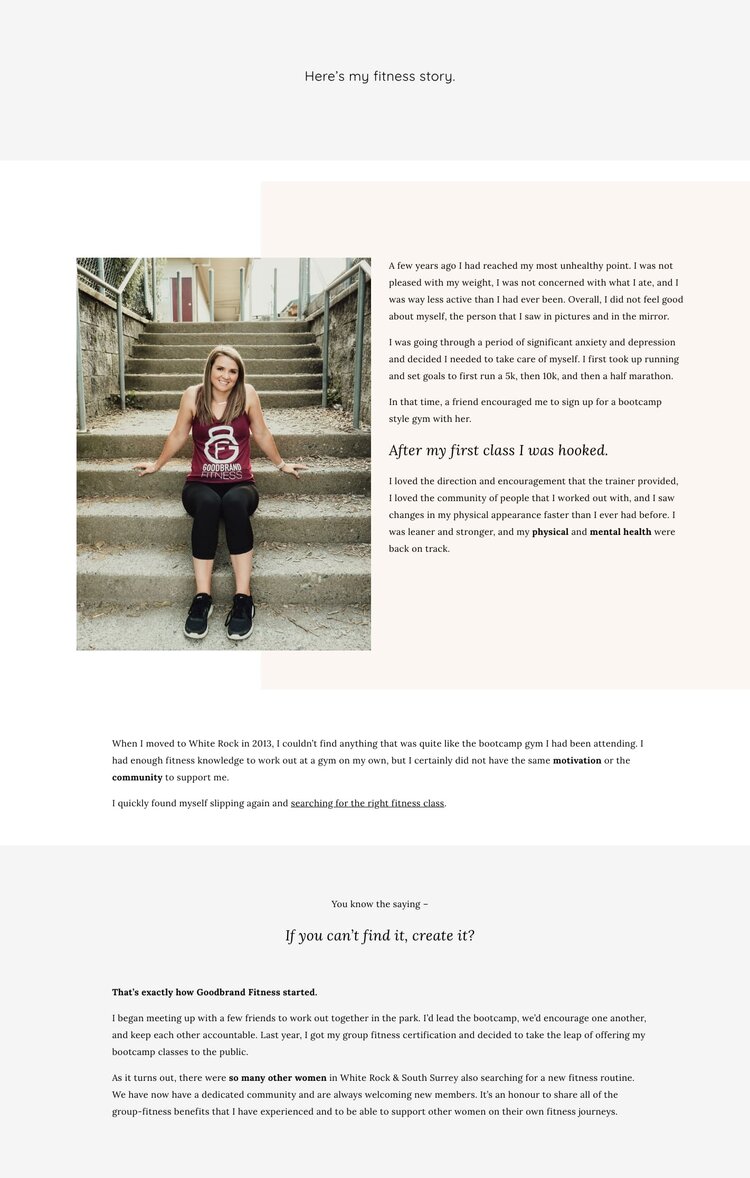
2) DO USE A STORY-TELLING STRUCTURE
Even a short anecdotal story! Find a place to share your journey in story-telling form, rather than in biography form. Reflect on where you started and where you are now. Share how you got here! It can be really simple, but adding these sorts of personal anecdotes is really helpful for giving your site visitors a point of connection to you.
Here’s a really brief example from Patty Ripley’s about page. She shares about where her love from colour comes from with a very quick anecdote about her grandmother giving her oil pastels to play with. It’s short, sweet, and simple, but personal and memorable.
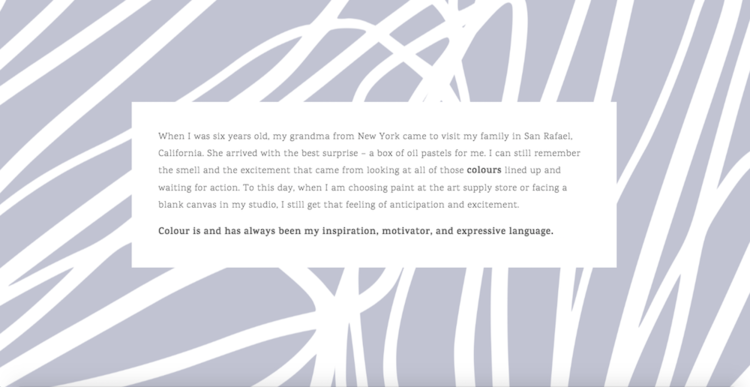
3) DO INCLUDE FUN THINGS
Your about page does not have to be serious and stuffy. I encourage you to include some short, fun-fact style details about you and what you do! Again, this is a really easy way to show what makes you unique.
Some ideas for how to structure this:
- A list of fun facts or things people might not know about you
- A list of your current favourites… (tv shows, books, podcasts, foods, drinks)
- A list of goals or dreams you have
- Your travel bucket list (for post-COVID-19 times!)
A really unique one that I love is from Ashlyn Carter’s website; she teaches copywriting and naturally has a brilliant about page that’s both informative and entertaining to read. She uses a quiz style “get to know me” section where she’s given her own answers to the quiz questions.
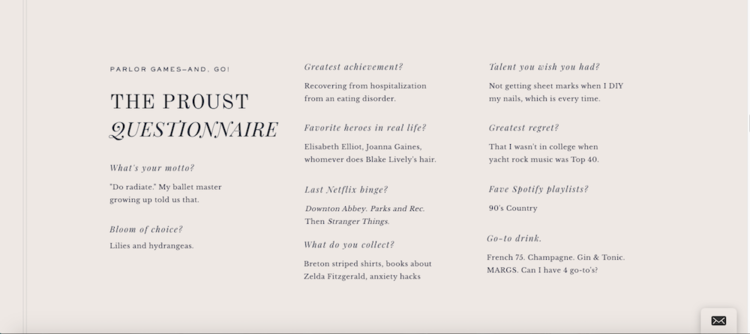
4) DON’T WRITE IN THIRD PERSON
If you’ve taken a glance through my site, you’ll notice I’m a fan of informal, conversational writing. Not sloppy, still professional, just not stuffy!
I see a lot of artist’s websites that sound like they’ve been written for a graduation ceremony. “Susie Smith (not a real lady) is a graduate of the graphic design program at Emily Carr and has been featured in photography exhibitions across the country…”
BO-RING.
Your about page is your chance to be yourself. To tell your story. To show some personality. You can be professional and personable; these are two compatible adjectives in my book. Start by writing in first person. Write as though you were talking to a friend or family member using “I” statements.
Amira Rahim does an awesome job of this! She talks about what art means to her and how she learned to paint her emotions – and she does this using a first person narrative. So much more engaging and relatable than a third-person style biography.
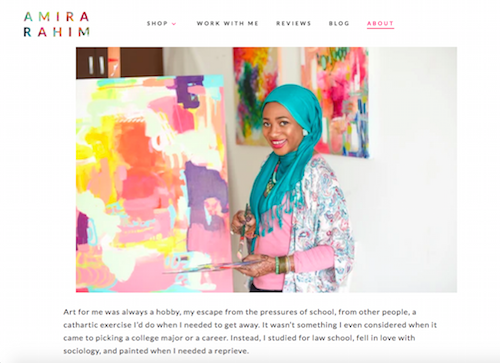
5) DO SHARE YOUR CREDENTIALS
If you’ve got the credentials, this is the place to flaunt them. Do this either by weaving them into your story or by having a CV section on your about page (the latter works specifically for artists).
Here are some examples of credentials you might include:
- Where you studied
- Who you’ve studied with
- Awards you’ve won
- Exhibitions of your work
- Publications you’ve been featured in
- Names of other artists you’ve collaborated with
- Initiatives or businesses you’ve started or work with
It’s not at all braggy to list these things, it shows you’re qualified, you’ve put in the time, and you’ve done the work.
6) DON’T FORGET TO INCLUDE SOCIAL PROOF
Social proof can be thought of as any affirmation of your offerings or services from another person or organization. For instance, if you’re a photographer – a review of your photoshoot. Or if you’re a painter – a testimonial from a happy customer who loves having your artwork hanging in their home.
As you’re building your creative business, it’s important to collect this sort of feedback as early as possible. If you’re just starting out, this can be as simple as reaching out to a few people you know who have used your services/purchased your offerings and asking them to write some kind words. If you’re well established with plenty of customers, you could consider streamlining the social proof-collecting process by adding it into your email marketing sequence. After making a purchase, your customer could receive an email with a thank you and some sort of incentive to leave you a review.
This is the important part. Once you’ve collected your social proof, you want to strategically place it throughout your website. Make sure that the reviews you include have a direct correlation to the story YOU are sharing on your about page. For instance, imagine you’re a photographer who’s defining thing is making people comfortable in front of the camera. You could write about this on your about page and then include a testimonial from a client sharing how you made them feel completely at ease during the photoshoot.
For almost a word-for-word example of this, check out the website I created for Saphren Lise Photography; she’s a master at getting people to be themselves during a photoshoot and the social proof on her website reflects that.
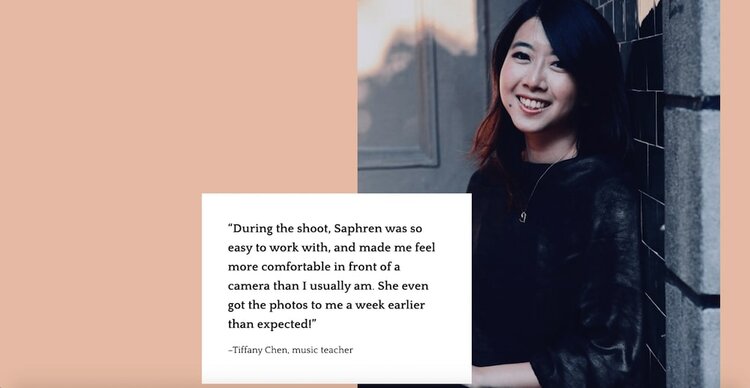
7) DO INVEST IN QUALITY PHOTOS (AND USE THE BEST ONES OF YOU!)
This is a big one, my friend. It’s important to have quality photos on your website. I’ve said it before on the blog and I’ll say it again. Your photos make all the difference. iPhone photos don’t look great on larger screen sizes; they tend to get pixelated and fuzzy. I recommend finding a way to get photos taken with a DSLR camera. The quality is much better and you will be much happier with the results.
If hiring a photographer isn’t in the cards for you, you can borrow a DSLR from a friend and take some yourself! Or, there’s lots of great options out there for professional stock photos.
Some great free resources:
Do make sure you’re including your favourite professionally-shot photos of yourself on the about page. Definitely aim to have a clear photo of your face looking at the camera. Again, no shame in doing-it-yourself! Borrow a camera and a tripod, find a nicely lit corner of your house, and you’re good to go.
Here’s a recap of my seven Dos and Don’ts for a creative’s about page:
DO
- Use a story-telling structure
- Include the fun, non-biography things
- Share your credentials
- Invest in quality photos
DON’T
- Just think about yourself
- Write in third person
- Forget to include social proof
Creating the about page is always my favourite part of any design project – probably because building relationships with my clients and investing in their story is what I do really well.
Are you looking to invest in your creative business with a custom-built brand and website that tells your story and helps you connect with your target customer? Head over to my client application page! 💛
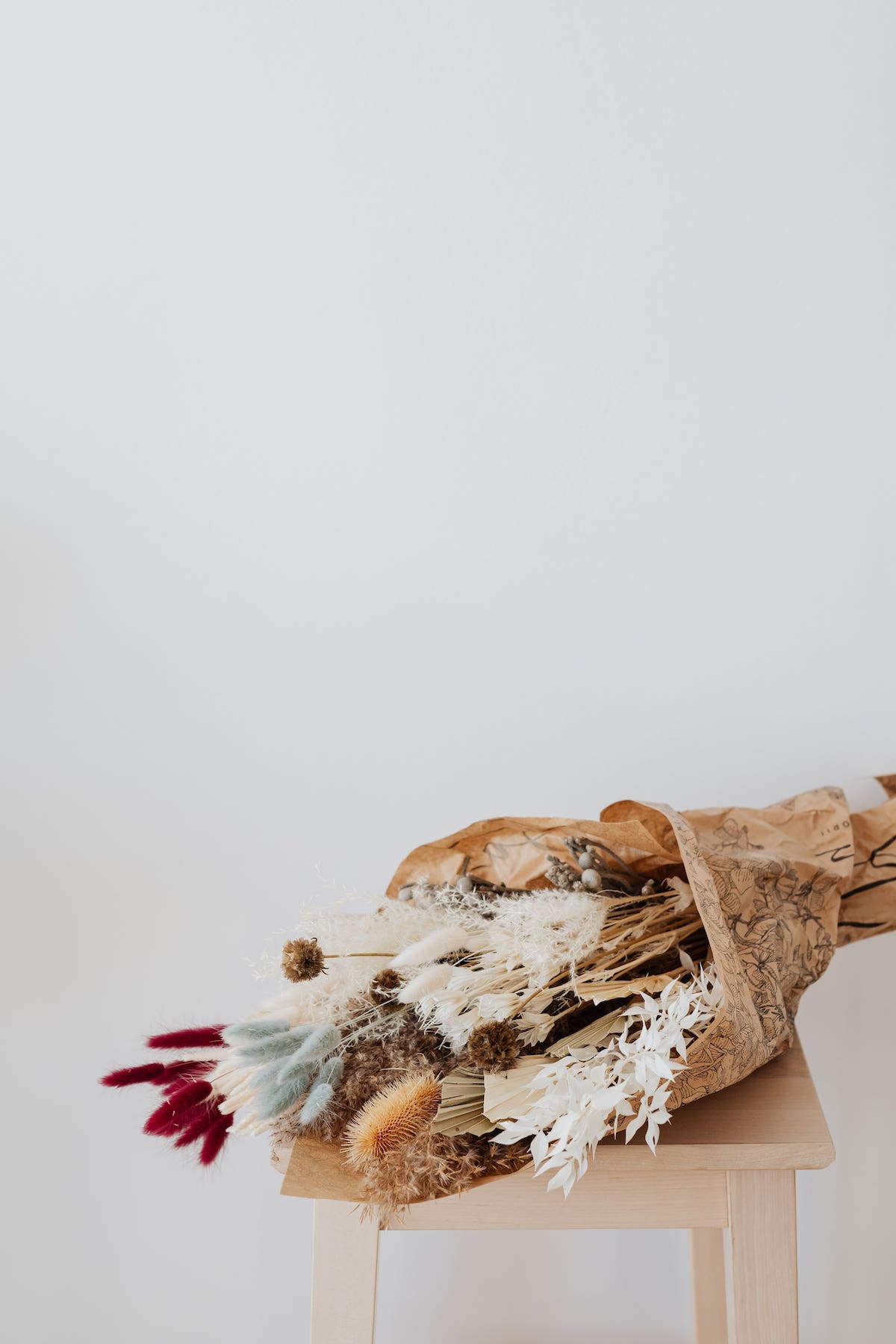
7 about page do’s and don’ts for creatives
September 16, 2021